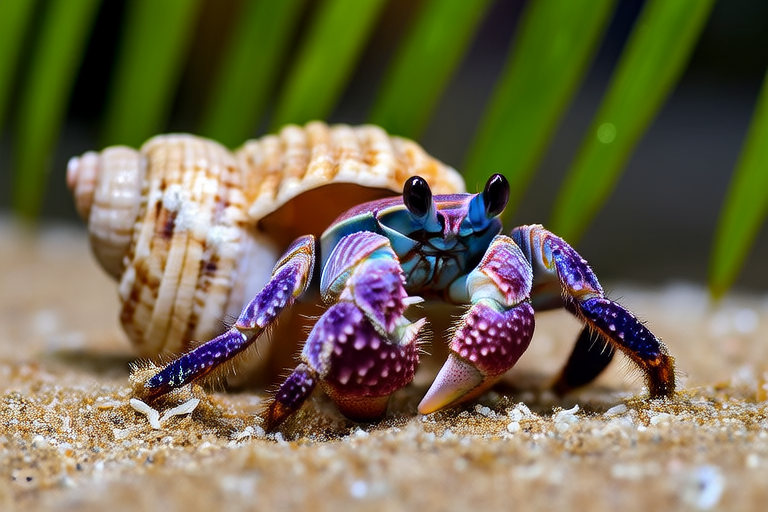Hermit Crabs: Unique Pets with Alien Charm
Hermit crabs have captivated pet enthusiasts for decades with their distinctive appearance and intriguing behaviors. These creatures, often described as both adorable and alien, offer a unique opportunity for pet owners to explore the wonders of crustaceans in a domestic setting. This article delves into the characteristics, care requirements, and peculiarities of hermit crabs, providing valuable insights for potential owners.
Diverse Species and Natural Habitats
Hermit crabs belong to the superfamily Paguroidea, comprising over 1,000 species distributed across tropical and subtropical regions. Among the most popular species kept as pets are the Coenobita clypeatus (Caribbean hermit crab) and Coenobita compressus (Ecuadorian hermit crab). Their natural habitats range from sandy beaches to rocky shores, where they scavenge for food and shelter.
Their diverse origins mean that hermit crabs are adaptable to various environmental conditions. However, recreating their natural habitat is crucial for their well-being. Owners must consider factors such as temperature, humidity, and substrate when setting up their tanks.
Setting Up the Ideal Tank
Adequate tank setup is essential for hermit crabs’ health and happiness. A 10-gallon tank is suitable for one or two medium-sized hermit crabs, but larger tanks are preferable for more crabs or those requiring more space. The tank should be equipped with:
- Substrate: Use a deep layer of sand, coconut fiber, or crushed coral to mimic their natural environment.
- Humidity: Maintain humidity levels between 70% and 80% using a hygrometer and misting the tank regularly.
- Temperature: Keep the tank at temperatures between 75°F and 85°F (24°C to 29°C) using a heat lamp or under-tank heater.
- Hiding spots: Provide ample hiding places with rocks, driftwood, and artificial caves.
- Shells: Offer a variety of shells for your crabs to choose from during molting.
It’s important to ensure the tank is escape-proof and has proper ventilation to prevent mold growth.
Dietary Needs
Hermit crabs are omnivorous scavengers, feeding on a wide range of foods in the wild. In captivity, their diet should include:
- Protein sources: Small pieces of fish, shrimp, or insects.
- Vegetables: Carrots, sweet potatoes, and leafy greens.
- Fruits: Apples, bananas, and berries.
- Variety: Offer a balanced diet with occasional calcium supplements and multivitamins.
Avoid feeding them processed human foods, as these can be harmful to their health.
Social Behavior
Hermit crabs are social creatures that thrive in groups. They communicate through scent and touch, and they enjoy interacting with each other. Providing enough space and enrichment is crucial to prevent overcrowding and stress. Owners should observe their crabs’ interactions and adjust the tank size accordingly.
Common Myths and Misconceptions
One common misconception is that hermit crabs require little maintenance. While they are relatively low-maintenance compared to other pets, they still need proper care to thrive. Another myth is that hermit crabs don’t need water. In reality, they require access to fresh and saltwater to maintain hydration and shell cleanliness.
Shells and Molting Process
Hermit crabs inhabit discarded mollusk shells, which protect their soft abdomens. As they grow, they outgrow their shells and need to find new ones. Owners should provide a variety of shells for their crabs to choose from during molting. The molting process involves shedding their exoskeleton and growing a new one, which can take several weeks. During this time, crabs may become lethargic and less active.
Importance of Space and Enrichment
Providing adequate space and enrichment is vital for hermit crabs’ well-being. A cramped tank can lead to stress and aggression. Owners should offer climbing structures, tunnels, and toys to stimulate their crabs’ curiosity and activity. Regular interaction with owners can also enhance their quality of life.
Personal Anecdotes and Stories
One memorable experience involved a hermit crab named Charlie, who was particularly fond of exploring his owner’s hand. His owner would place Charlie on her palm, and he would walk around, investigating every nook and cranny. Another story highlights the joy of watching hermit crabs interact with each other, playing and sharing food in their tank.
Hermit crabs are fascinating and rewarding pets, offering a unique glimpse into the world of crustaceans. With proper care and attention, they can provide years of companionship and entertainment.
